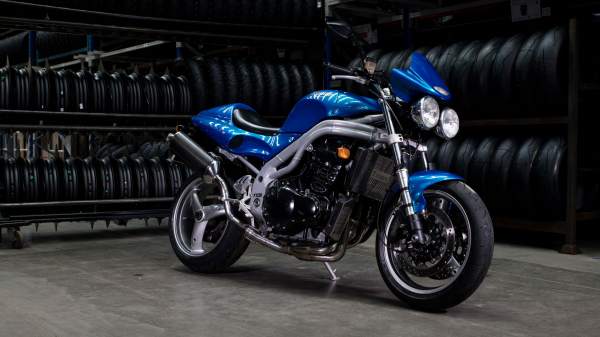
With the arrival of the all-new Triumph Speed Triple 1200, it’s timely to look back at how the bloodline of the UK firm’s premium naked came to be, having established itself as a firm favourite in the British marque’s line-up since its launch in 1994.
Back in 1993 reborn Triumph was at a crossroads. It’s all-new range of modular triples and fours, as launched in 1991, had already stunned the motorcycling world with their competence, performance and reliability but there were also already rumblings that their style was too conservative and safe.
Initially, six models had been unveiled: 750 and 900cc three-cylinder Trident roadsters; 750 and 1000cc three and four cylinder Daytona sportsters and 900 and 1200cc three/four cylinder Trophy tourers. All shared identical steel spine frames, similar, proven cycle parts and even largely identical bodywork – particularly their tanks, side panels and seats.
2921 TRIUMPH SPEED TRIPLE 1200 RS
Some were also quickly identified to be more successful than others, with the more characterful, individual Trident 900 standing out, while the 1000cc Daytona, by comparison, bland and uncompetitive against the latest, sophisticated Japanese superbikes. This led to increasing experimentation within Triumph’s modular approach: a Daytona 900 and 1200, for example, arrived in 1993.
At the same time, Triumph had also recently opened its own in-house paint shop, which improved paint quality significantly, updated the rear bodywork on some of its models and was getting positive feedback for adding individuality. The half-faired Trident Sprint arrived in 1993 and had been well received. The question was: which direction should Triumph take next?
Brit Michael Lock, now CEO of American Flat Track racing and a previous boss of Ducati USA, was Triumph’s export sales manager at the time, having joined from Honda Europe, and remembers it well:
“It became clear to me quite quickly that Triumph was, on the one hand this heritage-soaked, evocative name, that got generations of guys hot and sweaty – and that was what John (Bloor) bought. But then what he made was this very modular, very engineering-led, somewhat subtle, not evocative motorcycle.
“What John wanted to do was kill the old image of Triumph that they were unreliable. That was his first goal – and he was right. But in doing that and in going for the modular system with the three and four cylinder engines with the cam chain running down the side which looked a bit like a Kawasaki, the bikes were very anonymous. He almost over-achieved his goal which was to have credibility but what he didn’t really do was create desire.”
The launch of a more "British" Triumph
Lock began having meetings with Triumph’s European importers and it was clear they wanted bikes with more character that were more distinctly ‘British’.
“Our European partners, who loved the brand, were saying ‘It doesn’t look very Triumph’,” Lock remembers. “As a result it was really difficult to sell it in Italy and Germany because what they didn’t want was a ‘Kawasaki’ made in England – they wanted a British brand, a British bike.”
Lock tells the tale how he and enthusiastic Italian importer, Carlo Talamo of Numero Tre, who were already also creating customized Hinckley Triumphs, began exploring what a new, ‘more British’ Triumph might be.
“I knew it was a winner,” says Lock today. “It was the Triumph I wanted to buy. Big black triple, engine, clip on bars. That was exactly the right bike – and it was easy to do.” Lock and Talamo then mocked up a bike in Italy and told Bloor about it who advised them to ‘Keep it in Italy until you’re happy with it because we don’t want a lot of fuss.’ The two did just than then flew the bike to England for give a presentation to Triumph senior managers.
“The management stood around and crossed their arms,” says Lock. “In fact one of them said: ‘It just looks like a crashed Daytona’. They didn’t get it. But on Day 2 we did a presentation to all the European distributors, unveiled the bike and several of them cried – it was the bike they wanted. It was big and brutish but it looked like a British café racer and it was the bike that changed Triumph.”
The name came from Hinckley marketing team, under Bruno Tagliaferri, as inspired by Triumph’s 1938 Speed Twin. And the result, although not the massive seller some envisage, selling around 6-800 bikes a year, was a massive shot in the arm for Triumph’s image. An entertaining, televised one-make race series, the Speed Triple Challenge, boosted its image further.
But the Speed Triple’s success only became a certainty with the launch of the second-generation version, designated internally as the T509, in 1997.
It seems amazing to realize it today, but that bike was almost an afterthought to the T595 Daytona on which it’s based – especially as, while the big Daytona was quietly killed off in 2004, the ‘Speedie’, and its successive variants, have lived on to be among the most successful Triumphs of all.
The T595 Daytona was an all-new design powered by Triumph’s most powerful triple to date and with styling by Brit John Mockett. The demand for a naked, Speed Triple version, came mostly from France and Italy and the distinctive, twin-beam ‘bug-eyed’ styling, meanwhile, was arrived at from the desire to build as authentic a ‘streetfighter’ as possible, with twin detached beams being a popular DIY streetfighter feature at the time.
But its success surprised even Triumph itself. Although the Daytona was initially the better seller, the Speed Triple slowly grew in stature then began outselling its stablemate as the company entered the new century.
By 2005, when the third all-new Speed Triple was built, the 1050, the Daytona was no more and Triumph’s super naked had grown to become the definitive example of the breed and a core model in Triumph’s line-up. Further updates and all-new models came, most significantly in 2011, which saw the then controversial switch from round to angular twin beams.
Since then the Speed Triple has evolved into a leaner, more imposing ‘super naked’ with updates in 2011 and 2016 keeping it fresh against newer opposition with an increase in power, new technologies and a greater focus on riding enjoyment.
Even so, the latest generation Speed Triple 1200 RS is the biggest step forward yet in terms of power and - according to Triumph - riding experience to prime it against fresh competition, including the new Ducati Monster launched at the tail-end of last year.
Until we get a chance to test it for ourselves, here’s hoping the new 1200 continues the legacy…
Triumph Speed Triple History - A Buyer's Guide
1994-1997 Speed Triple 900 (T309)
Based on Daytona 900 but unfaired, with bold black, tallow or orange paint, special badging and white-faced clocks. A few Speed Triple 750s were also built.
885cc (76 x 65mm)
98bhp @ 9000rpm/60ftlb @ 6500rpm
209kg dry
1997-1998 Speed Triple (T509)
All-new and based on then new T595 Daytona sportsbike.
885cc (76 x 65mm)
108bhp @ 9000rpm/62ftlb @ 6500rpm
196kg dry
1999-2002 Speed Triple 955
Bigger bore improves power and torque. Also gains larger silencer.
955cc (79 x 65mm)
118bhp @ 9200rpm/72ftlb @ 5800rpm
196kg dry
2002-2005 Speed Triple 955i
Updated with bigger airbox, valves and raised compression plus other changes including a sharper chassis, more angular rear bodywork and smaller headlights.
955cc (79 x 65mm)
120bhp @ 9100rpm/74ftlb @ 5100rpm
189kg dry
2005-2007 Speed Triple 1050
First ‘stand-alone’ Speed Triple has no Daytona sports sibling, is all-new and considered more aggressive still.
1050cc (79 x 71.4mm)
131bhp @ 9250rpm/77ftlb @ 7500rpm
189kg dry
2008-2010 Speed Triple 1050
Update with extended pillion seat, Brembo instead of Nissin brakes and new wheel design.
1050cc (79 x 71.4mm)
131bhp @ 9250rpm/77ftlb @ 7500rpm
189kg dry
2011-2015 Speed Triple
All-new model with angular headlights to replace the synonymous dual headlamps, new frame with sportier geometry, subtle engine mods and new bodywork. Hi spec ‘R’ version added in 2012.
1050cc (79 x 71.4mm)
135bhp @ 9200rpm/82ftlb @ 5800rpm
214kg (wet)
2016 Speed Triple S & R
Standard bike now called S with higher spec R. Updates include reshaped bodywork, narrower tank, different headlights and new electronics package including five modes.
1050cc (79 x 71.4mm)
138bhp @ 9500rpm/82ftlb @ 7850rpm
192kg dry
2018 Speed Triple S & RS
S and hi-spec R versions updated into new S and RS with 10 extra bhp, full colour TFT dash and more.
1050cc (79 x 71.4mm)
148bhp @ 10,500rpm/86ftlb @ 7150rpm
192kg dry
